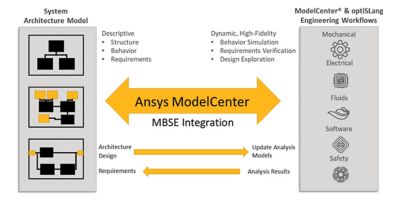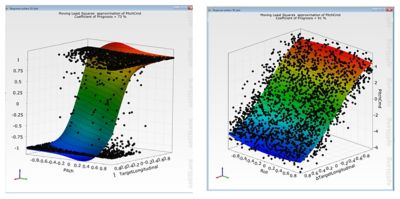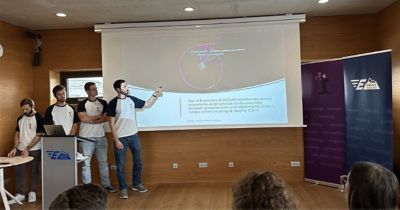Autonomy is trending in industries from manufacturing and industrial equipment to automotive and aviation. As a result, advanced air mobility (AAM) companies are developing different levels of autonomous aircraft to transport people and cargo between places more effectively for a multitude of use cases, including emergency services, agriculture, defense, industrial, and search and rescue. Although the terms are often used interchangeably, urban air mobility (UAM) and regional air mobility (RAM) are subsets of AAM, which focus on air transport at lower altitudes in urban and suburban areas, respectively. These autonomous aircraft are also commonly referred to as unmanned aircraft systems (UAS) or unmanned air mobility (UAM).
Emerging development in AAM includes electric vertical takeoff and landing (eVTOL) aircraft. In addition to their potential convenience, eVTOLs may support sustainability by offering a cleaner ride option for this new emerging market with reduced emissions and pollution. With interest and anticipation growing around eVTOLs, the global eVTOL aircraft market is expected to reach $23.4 billion by 2030. In fact, the Vertical Flight Society, which maintains the World eVTOL Aircraft Directory, announced that its catalog now contains more than 900 designs from more than 400 companies and innovators around the world.
However, building safe eVTOLs requires complex design, development, manufacturing, and training. Simulation offers incredible value in this area, helping to build confidence in autonomous AAM systems, ensure their reliability, and validate their safety. By integrating Ansys solutions, AAM companies can adopt a seamless end-to-end workflow using elements like multiphysics simulation, software design, and digital mission engineering. Let’s take a closer look at the digital engineering journey for an eVTOL, from mission planning and concept selection to design and operation.
Select Your Mission Concept, and Start Planning
The eVTOL digital engineering journey begins with mission planning, concept selection, and safety. Engineers and designers can use Ansys Systems Tool Kit (STK) digital mission engineering software to define an eVTOL’s mission with a system-of-systems approach. The STK platform enables you to model complex systems inside a realistic and time-dynamic 3D simulation, including high-resolution terrain, imagery, and radio frequency (RF) environments. This critical insight helps you design a safer mission, considering unforeseen variables.
At the same time, mission definition involves the assessment of mission capability, concept, and the design reference mission (DRM). The DRM is basically a detailed plan or mission profile that captures the asset’s operating scenario in a system-of-systems context, including other assets, terrain, and weather conditions. The DRM captured in the STK platform helps engineers and designers meet vehicle system requirements to ensure the success of the planned mission. For instance, eVTOL design must often consider emerging requirements like connectivity to other air vehicles, satellites, and base stations.
The design reference mission (DRM) for an eVTOL is captured and illustrated using Ansys Systems Tool Kit (STK) digital mission engineering software.

Ansys’ model-based systems engineering (MBSE) tools can easily integrate with the system architecture model and multiphysics engineering workflows.
The next step is to decide which concept has the best system configuration and performs most effectively, efficiently, and safely by conducting a trade study on possible configurations. An important component in this assessment is the system architecture model. The system architecture model serves as an “authoritative source of truth” for everyone working on the project. Ansys offers a cloud-native system architecture modeler (SAM) designed to support real-time collaboration and integrate the system architecture model with engineering analysis workflows.
You can use Ansys ModelCenter MBSE software to capture the operation and mission defined previously in the STK platform and connect this data to the SAM as the operational data. This enables you to connect, describe, and illustrate your overall system, technology options, configuration possibilities, and initial system behavior.
You can also connect the SAM to analytical models like digitized specification sheets, analytical equations, transfer functions, and reduced-order models (ROMs), thus enabling trade studies to get the initial system configuration that meets the requirements for mission success.
With a “smarter” model that’s more connected, you can examine the system’s functional safety and cybersecurity architecture. Using a tool like Ansys medini analyze functional safety system analysis software, you can check your system against regulatory standards for aerospace systems, including the Aerospace Recommended Practice (ARP) 4754 and ARP4761 from SAE International, as well as the Military Standard (MIL-STD) 882E System Safety from the U.S. Department of Defense.
The operation and mission defined in STK software connects with the system architecture model using Ansys ModelCenter model-based systems engineering (MBSE) software and Ansys’ cloud-native system architecture modeler.
Integrate and Optimize Your Designs
Once you’ve established your mission, you can use a model-based approach to design systems of interest to capture the physical nature of the system using lower-fidelity models like circuit models. In eVTOL design, key areas to model include propulsion, flight dynamics, sensors, guidance navigation, and control systems. In the Ansys workflow, the Ansys SCADE Suite model-based development environment for critical embedded software is also used at this point to check that the modeled hardware and software are in sync. The SCADE environment is built for embedded software, providing linkage to requirements management, model-based design, verification, certified code generation, and interoperability with other development tools and platforms.
To dive deeper into design, you can use Ansys multiphysics solutions to analyze how 3D geometry components behave under different operating conditions using higher-fidelity models. For example, to accurately model an eVTOL’s electro-optical infrared (EOIR) sensor, you must consider electromagnetic, optical, thermal, structural, and aerodynamic impacts on the EOIR as it operates to ensure that it meets all the requirements.
Ansys multiphysics simulation tools are incredibly helpful for achieving a more comprehensive and detailed design, though high-fidelity models of specific components can take a lot of time to analyze and run. To accelerate the simulation workflow, Ansys offers techniques powered by artificial intelligence (AI) and machine learning (ML) that decrease model complexity by enabling ROMs. These AI/ML-driven techniques and ROM capabilities are built into Ansys optiSLang process integration and design optimization software, the Ansys Twin Builder simulation-based digital twin platform, and the Ansys SimAI cloud-enabled generative artificial intelligence platform. ROMs can be integrated more quickly and easily to perform model-in-the-loop (MIL) and hardware-in-the-loop (HIL) analyses. As such, ROMs of eVTOL sensors, vehicle dynamics, and propulsion systems can be integrated more simply than high-fidelity models to verify guidance, navigation, and control systems.

Through sensitivity analyses in Ansys optiSLang software, an oscillation issue was identified (left) and addressed to achieve smoother flight (right).
Validate, Operate, and Maintain Your Mission
In the final stages of the eVTOL digital engineering journey, you can model your integrated system against your initial DRM to validate that it meets mission success criteria.
Finally, as the eVTOL goes into operation, telemetric data from the asset can be fed into a digital twin to assist in prognostic health management and maintenance. For example, you can predict its battery health by monitoring its current voltage behavior with a digital twin.
Virtual verification and validation using the STK, SCADE, and Twin Builder platforms enable optimized flight testing and performance, potential failure forecasting, and proactive maintenance.
Fly Toward Autonomy With Digital Engineering and AI/ML
Ansys’ solutions empower customers to build confidence around different levels of autonomous AAM systems. By combining Ansys’ digital mission engineering and multiphysics simulation with AI/ML-driven modeling methods, customers can more efficiently develop and validate eVTOLs within a realistic 3D environment.
To explore Ansys multiphysics solutions firsthand, browse free product trials. To experience Ansys’ system-of-systems simulation, check out free trial options for the STK platform.
Learn more about Ansys’ autonomy solutions in the on-demand webinar “Ansys Autonomy: Automating Embedded Planning and Controls via Model-based Software Solutions.”
Discover how the SimAI platform transforms design across industries in the blog “From Chips to Ships: Optimize Design With the Ansys SimAI Platform.”

















